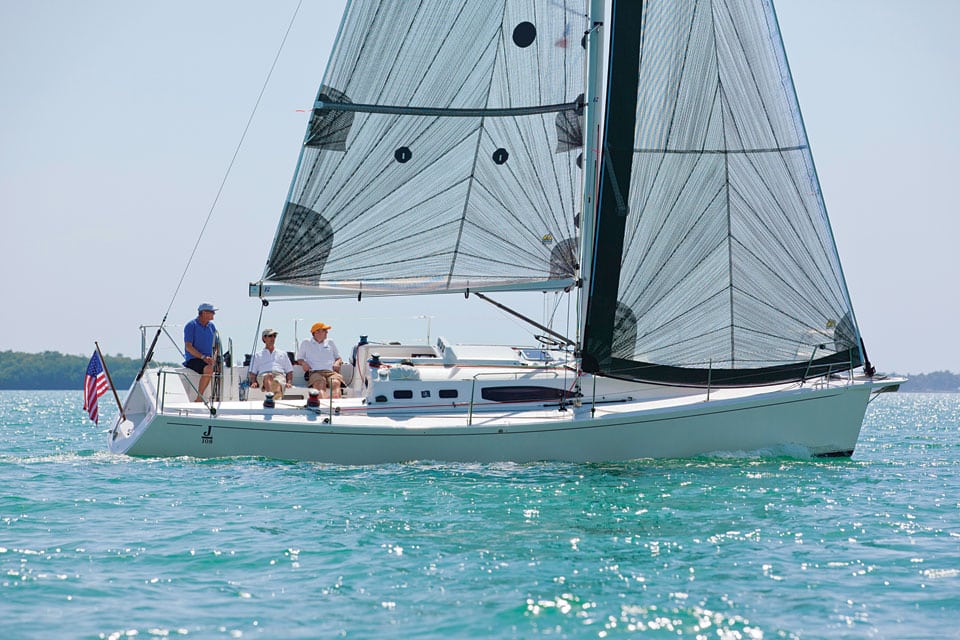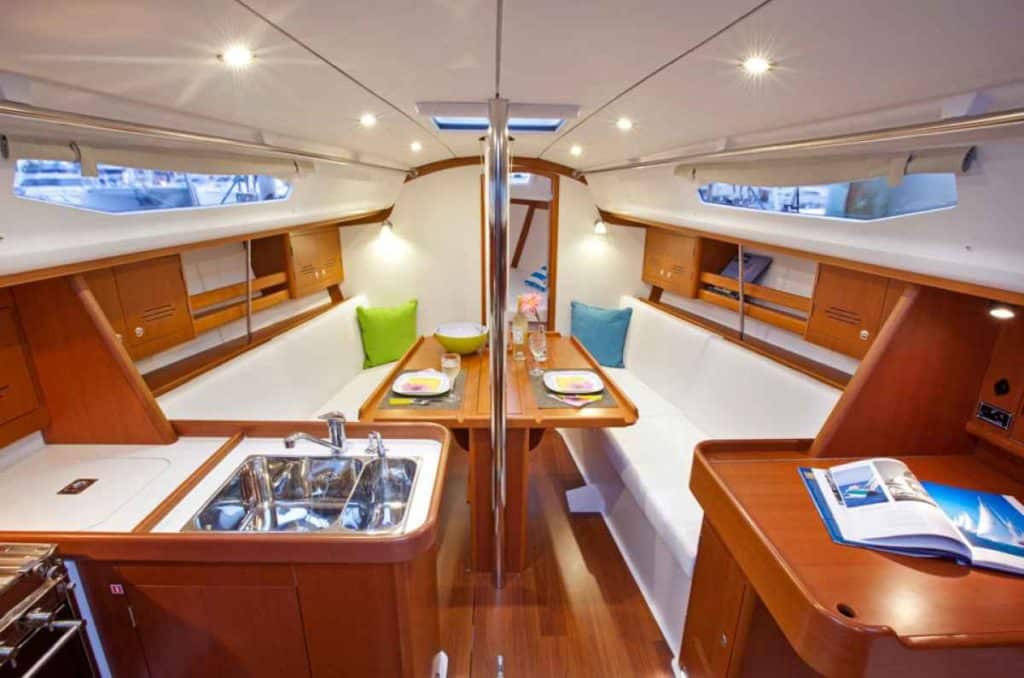
J/108 Review
Introduced in late 2009, the 31-foot J/95 was pitched as a “shoal-draft performance cruiser.” Had it not been racing legend Rod Johnstone himself assuring us that shoal performance wasn’t an oxymoron, the concept may have met with considerable market resistance. But Johnstone was quick to remind us that many of the great racing yachts of yore were centerboarders, including Carleton Mitchell’s Finisterre and Ted Hood’s Robin.
Johnstone was adamant that shoal-draft vessels actually make better sea boats than their deep-keeled cousins. Because their ballast is closer to their axis of pitch, there’s less inertia and therefore less hobbyhorsing. In theory, they negotiate the waves with a smoother motion, and that translates into more comfort and speed, glorious speed.
A commercial and critical success, the J/95 did prove to be a fast, versatile, and easily managed yacht that indeed could handle the back bayous as easily as the big blue. What it didn’t offer, however, was the normal accoutrements of a true cruiser: standing headroom, a full-service galley, ample accommodation, and cruising cargo capacity.
Enter the 35-foot J/108. The core concept and features—high performance, shoal draft, twin rudder, centerboard—are the same. But with 4 more feet on deck and 18 more inches of beam, the 108 offers a legitimate cruising interior for a full-size family or racing crew.
The hull shape is taken from the successful J/109 (sans the fixed keel) with long, low lines, a near-plumb stem, and an open reversed transom. But instead of the 109’s 7 feet of draft, the 108 sports a sophisticated centerboard trunk that draws a mere 4 feet.
The trunk provides a surprising amount of lateral resistance; on a Chesapeake Bay test sail in light winds, the boat performed well to windward even with the board up. But when that board was dropped to its 6-foot-10-inch maximum draft, we started to enjoy J/Boats’ signature upwind performance.
For the club racers out there, the P.H.R.F. will be approximately 96. With a SA/D of 19.0 and a D/L of 179, cruising capacity aside, this baby wants to fly. We actually matched true-wind speeds through the range of 4 to 6 knots. The large mainsail with small jib made it surprisingly easy to handle, and I found all the necessary controls within easy reach of the helm. To certify its cruising credentials, the 108 has a short anchoring platform that extends forward of the stem. This also proved to be a convenient spot to tack a furling asymmetric. With flat sections and low wetted surface, the boat enjoys a board-up downwind romp.
If centerboarders of old had an Achilles’ heel, it was that they tended to heel more, causing their rudders to lose grip, which produced an effect similar to weather helm. But the twin rudders ensure positive helm on even the heaviest of heels.
With 19 gallons of fuel, 33 of water, and 12 of waste capacity, the 108 will most likely find its niche in the weekend or coastal-cruising market. But make no mistake, the boat is built to Category A Ocean standards, has a commendable 14-inch bridgedeck to prevent downflooding, boasts a stiff, 129-degree angle of vanishing stability, is equipped with a keel-stepped mast, and is rigged for heavy-duty weather.
Contemporary racer/cruisers like the J/108 err towards the performance side with a large wheel and full-width traveler. The racing cockpit configuration normally makes it difficult for the helmsman to access the sheets and cabin-top running rigging, leaving those duties to the normally numerous crewmembers. Also, the positioning of the prominent traveler, an area of high load and quick action, is too often responsible for boat bites. This is a serious concern when the family is on board.
Johnstone solved all this by running the traveler athwart the cockpit sole just aft of the truncated cockpit benches. This still allows for wide sheeting adjustments but places the track where feet and fingers aren’t likely to fall. The wheel is a full 50 inches in diameter, but the benches to either side act as steps up toward the coaming and cabin-mounted winches. There is a large, removable aft seat/locker. In place, the cockpit is enclosed and family friendly. Removed, the transom is open and the boat’s race ready. It’s a very clever win/win compromise.
The decks are exceptionally wide, and the flow forward is excellent, although the foredeck could use more handholds. A low-profile vertical windlass is offset to port just forward of a deck-accessed rode locker. A lot is happening in the confined space of that fine bow: cleats, pulpit, ground tackle, and the like. I had difficulty clearing the anchor from underneath the furler. Perhaps a longer slot in the platform or a different style of anchor shank would correct this.
The varnished wood/white Formica interior is unpretentious yet practical. There’s an aft cabin to port with a spacious twin berth, changing seat, and full hanging locker. The forward V-berth offers good stowage, shelving, and another hanging locker.

A drop-leaf table runs down the center of the main saloon, with comfortable seats to either side that double as sea berths. A full-size head and shower compartment sits to starboard aft. The galley comes complete with twin stainless-steel sinks, a three-burner stove/oven, pressurized hot and cold water, a 90-liter icebox/fridge, and generous countertop space and stowage capacity.
A forward-facing chart table houses the instrumentation and electrical panel. The 30-horsepower Volvo diesel and saildrive lies under the companionway steps and is also accessed via doors in the head and aft cabin.
The J/108 should appeal to a broad range of sailors. By combining light yet strong, modern materials with the latest developments in keel, rudder, and rig designs, J/Boats has, with surprisingly little concession or compromise, delivered a vessel that promises pulse-pounding performance. Yet the boat remains simple enough to operate shorthanded, versatile enough to sail from shallow inland waters to the deep blue sea, and safe enough to bring the entire family along for the ride. And a joyful ride it will be.
Specs
LOA 35′ 0″ (10.67 m.)
LWL 30′ 6″ (9.30 m.)
Beam 11′ 6″ (3.51 m.)
Draft (board up) 4′ 0″ (1.22 m.)
Draft (board down) 6′ 10″ (2.10 m.)
Sail Area (100%) 603 sq. ft. (56 sq. m.)
Ballast 4,400 lb. (1,996 kg.)
Displacement 11,400 lb. (5,172 kg.)
Ballast/D .39
D/L 179
SA/D 19.0
Water 33 gal. (125 l.)
Fuel 19 gal. (70 l.)
Holding 12 gal. (45 l.)
Mast Height 51′ 1″ (15.57 m.)
Engine 30-hp. Volvo D1-30 with saildrive
Designer R. Alan Johnstone
Price $249,950 (base)
J/Boats Inc.
(401) 846-8410
www.jboats.com
Boat of the Year judge Alvah Simon’s classic tale of Arctic adventure, North to the Night, is now available on Kindle.








